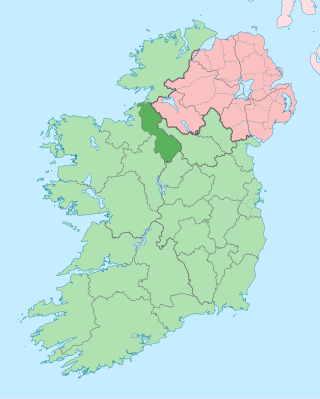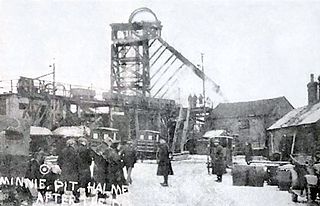
County Leitrim is a county in Ireland. It is in the province of Connacht and is part of the Northern and Western Region. It is named after the village of Leitrim. Leitrim County Council is the local authority for the county, which had a population of 35,199 according to the 2022 census.

Turlough Hill, also known as Tomaneena, is a 681-metre-high (2,234 ft) mountain in County Wicklow in Ireland and site of Ireland's only pumped-storage hydroelectricity plant. The power station is owned and operated by the ESB and can generate up to 292 megawatts (392,000 hp) of electricity at times of peak demand.

Drumshanbo is a small town situated in the heart of County Leitrim, Ireland. Drumshanbo is surrounded by a scenic area of soft rolling hills, woodlands, lakes and the Sliabh an Iarainn and Arigna mountains. It is a well preserved town with traditional pubs, shops, and restaurants.

Ballyfarnon is a village in northern County Roscommon, Ireland. Built on the River Feorish at the foot of Arigna Mountain, it lies between Loughs Skean and Meelagh with Lough Arrow, Lough Allen, Lough Bo and Lough-na-Sool nearby. It lies on the Sligo/Leitrim R284 regional road on the border with County Sligo.

Castlecomer is a town in the north of County Kilkenny, Ireland. It is positioned at the meeting of N78 and R694 roads about 16 km (9.9 mi) north of Kilkenny city. At the 2016 census, Castlecomer had a population of 1,502 people. The town is in a townland and civil parish of the same name.

The South Wales Coalfield extends across Pembrokeshire, Carmarthenshire, Swansea, Neath Port Talbot, Bridgend, Rhondda Cynon Taf, Merthyr Tydfil, Caerphilly, Blaenau Gwent and Torfaen. It is rich in coal deposits, especially in the South Wales Valleys.

Tower Colliery was the oldest continuously working deep-coal mine in the United Kingdom, and possibly the world, until its closure in 2008. It was the last mine of its kind to remain in the South Wales Valleys. It was located near the villages of Hirwaun and Rhigos, north of the town of Aberdare in the Cynon Valley of South Wales.

Geevagh is a village in the south-east corner of County Sligo, Ireland, on the R284 regional road. The name, meaning "the windy (place)", describes a climatic feature of the village and its surrounding countryside. The name Geevagh also refers to the local Catholic parish, the boundaries of which are wider than those of the village itself.

Mining in Wales provided a significant source of income to the economy of Wales throughout the nineteenth century and early to mid twentieth century. It was key to the Industrial Revolution in Wales, and to the whole of Great Britain.
Gluaiseacht Cearta Sibhialta na Gaeltachta or Coiste Cearta Síbialta na Gaeilge, was a pressure group campaigning for social, economic and cultural rights for native-speakers of Irish living in Gaeltacht areas. It was founded in Connemara in 1969 to highlight the decline of the Irish language and to campaign for greater rights for Irish speaking areas in the area of access to services, broadcasting and ultimately an elected assembly of their own. It was later named Gluaiseacht na Gaeltachta.
Aughamucky, officially Aghamucky, is a small village in County Kilkenny, Ireland. It is off the N78 road, about 3 kilometres east from Castlecomer.
The Deerpark Mines, about 3 km north of Castlecomer, County Kilkenny, were the largest opencast coalmines in Ireland, giving great employment to the area. The mines produced anthracite, a natural smokeless fuel, which unlike other forms of coal is not a major contributor to air pollution and air pollution-related deaths.

Ballingarry Coal Mines are underground coal mines located near the village of Ballingarry, County Tipperary, Ireland. Situated near the border with County Kilkenny, the mines are now disused and have flooded. Other nearby centres of population are Killenaule and New Birmingham.

The Minnie Pit disaster was a coal mining accident that took place on 12 January 1918 in Halmer End, Staffordshire, in which 155 men and boys died. The disaster, which was caused by an explosion due to firedamp, is the worst ever recorded in the North Staffordshire Coalfield. An official investigation never established what caused the ignition of flammable gases in the pit.

The Miners' Way and Historical Trail is a long-distance trail in Ireland. It is a 118-kilometre (73-mile) long circular route that begins and ends in Arigna, County Roscommon. It is typically completed in five days. It is designated as a National Waymarked Trail by the National Trails Office of the Irish Sports Council and is managed by Roscommon Integrated Development Company, Roscommon County Council, Leitrim County Council and Sligo County Council. The trail was developed to encourage tourism in the area in the wake of the closure of the Arigna mines in 1990. The route was originally conceived by a local priest, Father Sean Tynan, and built with funding from the European Regional Development Fund. The trail was opened by broadcaster Donncha Ó Dúlaing in July 2000.

Bradford Colliery was a coal mine in Bradford, Manchester, England. Although part of the Manchester Coalfield, the seams of the Bradford Coalfield correspond more closely to those of the Oldham Coalfield. The Bradford Coalfield is crossed by a number of fault lines, principally the Bradford Fault, which was reactivated by mining activity in the mid-1960s.

Singrauli Coalfield is spread across the districts of Singrauli and Sonebhadra in the Indian states of Madhya Pradesh and Uttar Pradesh, mostly in the basin of the Son River.

Brian Leyden is an Irish writer. He has published three novels, two short story collections and a best selling memoir. He has co-written a script for a feature film, made radio documentaries and is a regular contributor to Sunday Miscellany on RTE Radio 1. In 2021 Brian Leyden was one of the founders of the independent regional imprint Lepus Print. https://www.lepusprint.com/

The Arigna Mining Experience is a centre dedicated to the coal mining history of Arigna over a period of 400 years, local geology and coal, as well as new forms of renewable energy. It is Ireland's first museum dedicated to coal mining.
Sliabh an Iarainn, anglicized Slieve Anierin, is a mountain in County Leitrim, Ireland. It rises to 585 metres (1,919 ft) and lies east of Lough Allen and northeast of Drumshanbo. It is part of the Cuilcagh Mountains. The mountain was shaped by the southwestward movement of ice age glaciers over millions of years, the morainic drift heaping thousands of drumlins in the surrounding lowlands. Historically there were many iron ore deposits and ironworks in the area. Irish mythology associates the mountain with the Tuatha Dé Danann, particularly the smith god Goibniu. Sliabh an Iarainn is an important natural heritage site with exposed marine and coastal fauna of paleontological interest



















